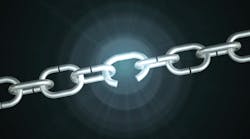Many don't realize how safety, or more importantly, the lack of it, can affect supply chain success. In fact the impact of an accident starts before the accident, and after the accident the ripple effect is overwhelming. Today we have the tools to identify almost every event stemming from an incident, whether or not it involves an injury or fatality. However, circumstances in today's workforce will, if not corrected, hinder improvement.
See Also: Manufacturing & Distribution Center Best Practices
Constraints of Being Green
Let's start with small companies. That's where the majority of our workforce works, and it is in these places where the cost to implement any version of an incident prevention plan is most often viewed as an avoidable cost. This is why we find a wide variety of incident prevention plans. The cost these companies try to avoid involves several aspects of developing and implementing comprehensive assessment and training. Much of the problem may stem from a company's focus or its having downsized, causing the existing workforce to be multi-taskers. Overtime and fatigue are the root cause for many incidents, but not all.
Some may think we are in a new age of technology and that software is the solution. This is a far-fetched notion, considering assessment and training often don't advance together. The human factor is technology's monkey-wrench. Our education system has not and does not prepare our present and upcoming workforce to help meet industry demands. Therefore, they stay green where safety on the job is concerned.
Conducting a training session recently, I overhead a comment from a facility manager, and I quote: "Where can I find people who know how to work?" He did not say want to work, he said, know how to work. This manager is finding out the hard way that training is now his responsibility. Our workforce is not coming from a pool of trained people. Basic work habits are not being trained at an early age, therefore our workforce, when they become adults, are far from what is needed to meet entry-level demands.
What's needed to prepare our young people for the future is entry-level basic skills training classes in our education system.
With technology moving at an increasingly fast pace, more is expected immediately in the workplace. Industry as a whole is trying to accomplish the goals it has outlined on paper with a workforce that is unprepared.
Recently, I sat in on a job interview and was amazed at the outcome. The questions presented were good, but when the interviewer was going over company policies, several questions were brought up about specific issues. Finally, the individual was asked, "Do you have any questions?" The reply was no! This was very interesting to me. Either I am very stupid or this individual was very smart.
With my experience, I had no clue where and how some of those policies applied within the company. Later we found out the truth as to why he answered no. The candidate did not want to look foolish during the interview; he wanted to make a good impression because he needed the job.
The Safety Chain
Once someone is on the job, methods for reporting incidents range across the board. Although things are moving in the right direction, some clients (contractors) are being asked for their incident history and many are finding they do not meet the new safety standards set by the general contractors. We have several clients who will not allow some vendors to drive on their property, much less conduct any type of service.
How do incidents affect the supply chain? Simple. Work stoppage. They require manpower to investigate, meetings and planning, workforce reorganization, improvements, training implementation, time to change old habits, evaluation of new work practices, downtime, overtime, production slowdown, dealing with quality issues, dealing with the loss of personnel, legal issues, and more.
And the ripple effect after an incident? It starts with the initial reaction, followed by trauma to both the family and the workforce, conducting a root cause analysis post incident, family and employee support/counseling, legal challenges, research, prevention measures and new equipment/repairs.
The bottom line will always come out the same: We must become better stewards of our workforce, provide better comprehensive training and stop assuming the workforce is knowledgeable.
Comprehend what's Comprehensive
To me, reporting incidents is a reaction to a problem and training is pro-action that represents money well spent, whether it prevents minor or catastrophic events. Yes, reporting should be standardized, made easy to complete and understand, but we live in a global economy now and when crossing borders or oceans we can always find someone who has some better ideas. Try to tour your supply chain for them. But remember, whatever the source, unless training takes a comprehensive perspective, it will always come back to haunt a company in some fashion—including waste, repairs, downtime, poor quality, late shipments and, in the worst case, a fatality.
A root-cause analysis may also be a reaction, but subsequent training and follow-up is a preventive measure that works, and as I mentioned, is money well spent. Such an analysis is an added cost in anticipation of an event, but it's also only the tip of an iceberg.
For the most part safety professionals do a great job. Nevertheless, bad things can still happen. Just recently, one of my clients had a fatal accident at one of its facilities. As outlined in their safety manuals and training, the investigation proved the employee was in non-compliance with the company's safety rules. That company lost a valuable employee and is experiencing all of the issues mentioned above.
Accidents Happen in the Best of Families
In all due respect to this client, they have one of the best organized safety cultures I have had the pleasure to work with in my 35 years in the material handling industry. Developing their safety culture beyond that point did not come cheap, but to them it is not a cost, it is an investment in their assets—and in their families. They empower their people, they evaluate their performance, give feedback, discipline as needed and reward often. This and much more has allowed this employer to achieve safety milestones second to none. Now the question is, will such a company allow outsiders to evaluate and publicize their achievements? I doubt it.
Earlier I mentioned that the supply chain is affected before the incident. How? In my opinion it all comes down to education and skills training. Our education system is failing to provide our workforce with basic entry level knowledge to help an individual understand the need to be safe on the job and at home.
Bad work habits do have chain reactions—even those chains that interconnect businesses with their families. Refocusing a staff member's attention on dealing with incidents is the ultimate disruption to a supply chain. It affects everything, including the quality of family life. What happens on the job is taken home, and the change-for-the-worse that happens there can then be brought back to the job to cause even more damage.
Over the years we have conducted training at facilities after major accidents. Unfortunately we found the workforce was apprehensive about attending. Although trying to implement change post-incident is almost impossible, allow time for the workforce to come to terms with the incident. Change can happen for the better.
Jim Shephard is president of Shephard's Industrial Training Systems (www.shephardsystems.com) and a member of MH&L's editorial advisory board. He specializes in matching people skills to a work environment.



